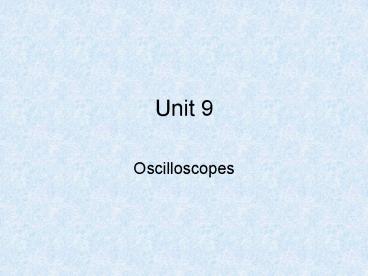Oscilloscopes - PowerPoint PPT Presentation
1 / 18
Title:
Oscilloscopes
Description:
Identify the basic parts of an oscilloscope and explain their functions. ... of test equipment available for working on electronic equipment and circuits. ... – PowerPoint PPT presentation
Number of Views:1660
Avg rating:3.0/5.0
Title: Oscilloscopes
1
Unit 9
- Oscilloscopes
2
- Objectives
- After completing this chapter, the student should
be able to - Explain the function of an oscilloscope.
- Identify the basic parts of an oscilloscope and
explain their functions. - Demonstrate the proper setup of an oscilloscope.
- Describe how to use an oscilloscope to make a
measurement.
3
- Oscilloscopes
- Most versatile piece of test equipment available
for working on electronic equipment and circuits. - Provides a visual display of what is occurring in
the circuit.
4
(No Transcript)
5
- Oscilloscopes provide
- The frequency of a signal.
- The duration of a signal.
- The phase relationship between signal waveforms.
- The shape of a signals waveform.
- The amplitude of a signal.
6
- The basic parts of an oscilloscope are
- A cathode ray tube (CRT).
- A sweep generator.
- Horizontal and vertical deflection amplifiers.
- Power supplies.
7
- Cathode-ray tube (CRT)
- A phosphor screen.
- Deflection plates.
- An electron gun.
8
- Faceplate
- Marked in centimeters along the vertical and
horizontal axis. - Can be calibrated with a known voltage before
testing an unknown signal. - Called a graticule, and is separate from the
oscilloscope. - Mounted in front of the CRT.
9
- Power switch
- Usually on the front panel.
- May be a toggle, push-button or rotary switch.
- Mounted separately or with another switch.
- Used to apply line voltage to operate the
oscilloscope.
10
- Intensity switch
- Also called brightness.
- Controls the electron beam within the CRT.
- It is a rotary control.
- Too much intensity for too long can burn a hole
or etch a line in the phosphor screen.
11
- Focus and astigmatism controls
- Connected to the electron gun.
- Used to adjust the electron beam size and shape.
- Rotary controls.
12
- Horizontal and vertical position controls
- Rotary controls.
- Allows the electron beam to be positioned
anywhere on the face of the CRT.
13
- Horizontal block
- Consists of
- A vertical input jack.
- An AC/DC switch.
- A volts/cm rotary switch.
- The oscilloscope probe is connected to the input
jack. - The probe is then connected to the circuit to be
tested.
14
- Horizontal block
- Also called the time base.
- Consists of
- A time/cm rotary switch.
- A trigger-control switch.
- A triggering level control.
15
- Level control
- Sets the amplitude that the triggering signal
must exceed before the sweep generator starts. - Initial oscilloscope control settings
- Intensity set to the center of range.
- Focus set to the center of range.
- Astigmatism set to the center of range.
- Position set to the center of range.
16
- Triggering INT
- Level AUTO
- Tine/cm 1 msec
- Volts/cm 0.02
- Power ON
17
- In Summary
- An oscilloscope provides
- Frequency of the signal.
- Duration of the signal.
- Phase relationships between signal waveforms.
- Shape of the signals waveform.
- Amplitude of the signal
18
- The basic parts of an oscilloscope are
- Cathode-ray tube (CRT).
- Sweep generator.
- Horizontal deflection amplifier.
- Vertical deflection amplifier.
- Power supply.































